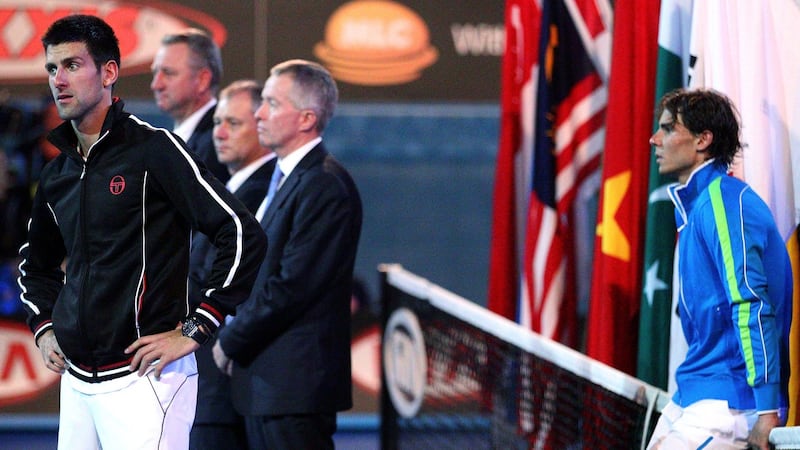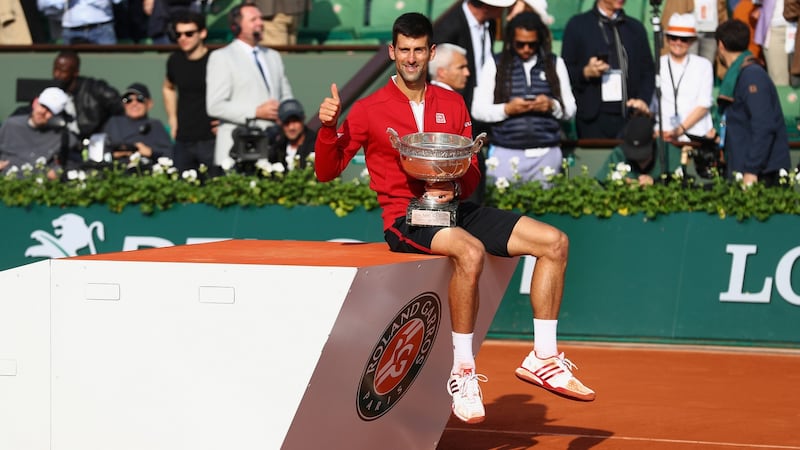In 2007, as Roger Federer wreaked havoc on the world, a young Serb with freakish flexibility and a wicked backhand began to put himself on the map. As he rose up the rankings, Novak Djokovic passed a series of players who lost to the best before they even stepped on to the court. People wondered aloud whether Djokovic was really any different.
“Why should I be frightened?” Djokovic responded. “For me it’s a totally normal thing. If you go out on the court thinking positively and thinking: ‘I can win against anybody,’ I think that’s a right thinking. If you go with the white flag on the court, what are you doing there?”
The story of Djokovic's breakthrough will always begin with Federer and Rafael Nadal, and how the future seemed clear before his arrival. By the end of 2007, Federer had won eight of the previous 10 slams. Immediately after Djokovic's first Australian Open in 2008, the Spaniard secured the French Open-Wimbledon double with one of the greatest matches of all time in the final of the latter. Djokovic was always tipped to compete for slam titles but the question was how consistently he could overcome two young legends of the sport.
Integrity
The answer took three long years as he dealt with physical afflictions and questions about his integrity, but when his breakthrough came it was breathtaking. Djokovic started the 2011 season with a 42-match winning streak, during which he dismantled Nadal in consecutive weeks on clay by daring to attack the most feared forehand in the world.
By the end of that year, he had captured three of the four slams and he stood at the summit of a changed sport. One of the most revealing perspectives of the shift was a simple video compilation of his post-match handshakes with Nadal as warm hugs became chilly handshakes. A distant challenger had ascended to an equal.

In the meantime, Djokovic has spent the decade making his case to be the greatest. He has flipped both head-to-heads, from 4-14 against Nadal in 2009 and 6-13 against Federer in 2010 to 29-26 and 27-23 today. He has been the common thread in innumerable classics, such as the 10 hours and 43 minutes of madness that comprised the semi-final and final of the 2012 Australian Open against Andy Murray and Nadal.
Most importantly, his dominance has yielded some of the most transcendent (and most under-appreciated) achievements in the history of tennis. By winning Roland Garros in 2016, he became only the third male player to simultaneously hold all four grand slam titles and the only player to do so across three different surfaces, and he broke the ATP ranking points record. In 2018 he became the only player to capture every variety of slam, Masters 1000 and World Tour Finals title.
With Djokovic, the discourse never fails to revert to discussions of personality and popularity. As the person who burst in and ended the dominance of the two most popular male players, there are contests he will never win. The actual tennis is far more interesting. While the effortlessness of Federer’s game and the endless grit within Nadal are constant tropes, it can be difficult to convey succinctly why Djokovic is their equal.
Djokovic’s strengths are clear. His ability to throw himself at full speed into low splits on either wing is astounding and has popularised sliding on hard courts. He is statistically one of the best returners of all time and his two-handed backhand has few equals. As his recovery from double championship point down in the fifth set of last year’s Wimbledon final against Federer showed, when the pressure is suffocating and everything is on the line, no player in history has been able to find such mental clarity in chaos.
Relentless grinder
Those strengths lead people to characterise Djokovic as a relentless grinder. But he is so much more. His serve has grown into a quietly devastating weapon, constantly generating free points and short returns. On the slowest of slow clay he can shred any opponent to dust, yet on faster courts he can be ruthlessly efficient. Djokovic’s game is easiest to appreciate live, where the difficulty for opponents of his frequent direction changes and the varying amount of spin he puts on the ball are more clear. A large part of his greatness is that he is so difficult to read. He can approach a match however he likes and the person on the other side of the net will often not grasp his intentions until the match is done.

The decade-long race between the big three will soon come to an end. Djokovic, 33, collected his 17th slam title at this year’s Australian Open, which puts him two slams from Nadal, 34, and three from Federer, 38. There is already a compelling argument that his head-to-head against all rivals, top-10 wins and the sheer magnitude of having to constantly break through the Federer-Nadal duopoly is enough.
Regardless, Djokovic continues to chase them down with speed. The No 1 has not lost a match this year and, after his third title of 2020 in Dubai, he said that his goal is to finish the season unbeaten. He later clarified that he was joking, but nobody laughed. After all, if anyone at all is capable of such an achievement, it is him and nobody else.
Roll of honour
17 grand slam singles titles
Australian Open 2008, 2011, 2012, 2013, 2015, 2016, 2019, 2020
French Open 2016
Wimbledon 2011, 2014, 2015, 2018, 2019
US Open 2011, 2015, 2018
79 singles titles in all
282 weeks as world No 1 - Guardian











